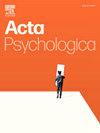外生注意及其与工作记忆内容的关系:超越空间选择
IF 2.1
4区 心理学
Q2 PSYCHOLOGY, EXPERIMENTAL
引用次数: 0
摘要
为了成功地完成日常活动,工作记忆(WM)和选择性注意等认知功能是必要的。具体来说,当环境需求是动态的,外生注意是至关重要的。然而,其选择和优先考虑感知空间位置的能力,以及WM中新颖的刺激-反应(S-R)绑定的能力在很大程度上仍未被探索。通过对利用WM的任务实施回溯线索范式,本实验的目的有两个:1)评估外源性线索效应是否不仅会影响空间加工,还会影响WM内容;2)探索干预事件(IE)的操纵所诱导的元控制状态如何调节这些效应。我们观察到(N = 50),外生注意导致空间选择,就像在空间外生注意范式中通常观察到的那样,但也会导致与该位置相关的内容。此外,空间选择受到IE操作的调节,这被认为会诱发两种元控制状态(持久与灵活)。因此,IE的存在也调节了参与者在新刺激-反应映射和重复刺激-反应映射方面的表现,再次暗示了内容在这项任务中的重要作用。这种发现模式非常符合事件文件的概念;在试验开始时组装的所有相关组件的心理表征(即线索、目标、横向化、元控制状态等),一旦遇到其中的一个或多个元素,这些组件就会被一起检索。虽然是初步的,但这一通过事件文件激活的外源性WM注意选择的证据为一个有前途的研究方向铺平了道路。本文章由计算机程序翻译,如有差异,请以英文原文为准。

Exogenous attention and its relationship with working memory contents: beyond spatial selection
To successfully perform everyday activities, cognitive functions such as working memory (WM) and selective attention are necessary. Specifically, when environmental demands are dynamic, exogenous attention is crucial. However, its ability to select and prioritize not only perceptual spatial locations, but also novel stimulus-response (S-R) bindings held in WM remains largely unexplored. By implementing a retro-cueing paradigm on a task that capitalized on WM, the present experiment's aim was two-fold: i) to evaluate whether exogenous cueing effects would not only impact spatial processing but also WM content, and ii) to explore how meta-control states induced by the manipulation of an intervening event (IE) would modulate these effects. We observed (N = 50) that exogenous attention led to selection of space, as it is usually observed in spatial exogenous attention paradigms, but also the content associated with that location. Moreover, space selection was modulated by the IE manipulation, which was thought to induce two meta-control states (persistent vs. flexible). As such, the presence of the IE also modulated participants' performance regarding novel vs. repeated stimulus-response mappings, again hinting at an important role of content in this task. This pattern of findings fits well with the concept of event file; a mental representation of all relevant components assembled at the beginning of a trial (i.e., cue, target, lateralization, meta-control state, etc.), which are retrieved together once one or more of its elements are encountered. Although preliminary, this evidence of exogenous attentional selection of WM through event file activation paves the way for a promising research line.
求助全文
通过发布文献求助,成功后即可免费获取论文全文。
去求助
来源期刊

Acta Psychologica
PSYCHOLOGY, EXPERIMENTAL-
CiteScore
3.00
自引率
5.60%
发文量
274
审稿时长
36 weeks
期刊介绍:
Acta Psychologica publishes original articles and extended reviews on selected books in any area of experimental psychology. The focus of the Journal is on empirical studies and evaluative review articles that increase the theoretical understanding of human capabilities.
 求助内容:
求助内容: 应助结果提醒方式:
应助结果提醒方式:


